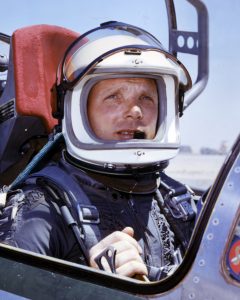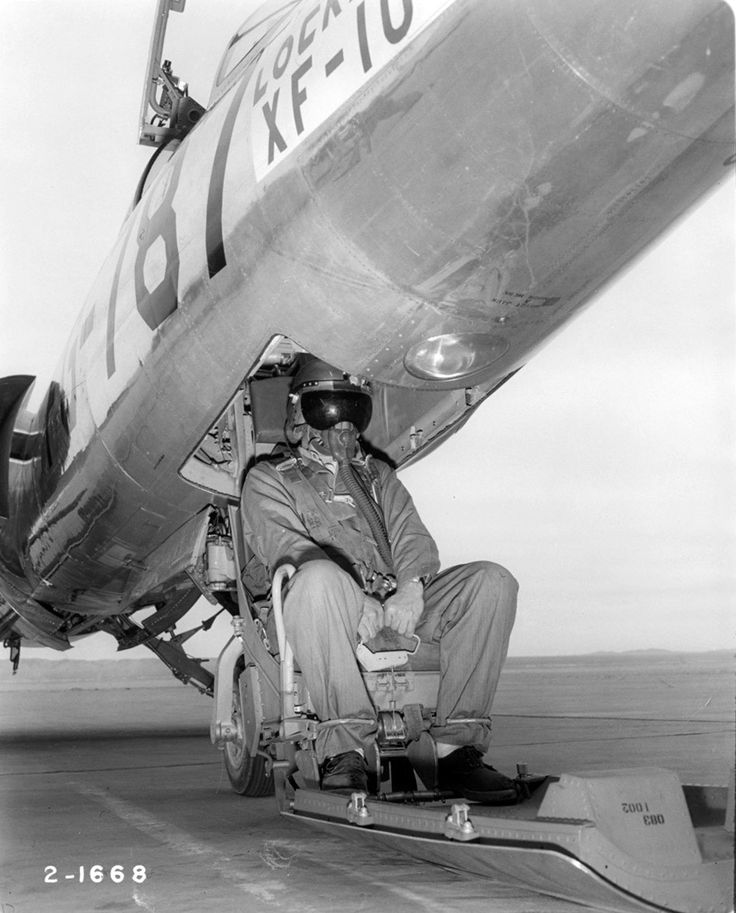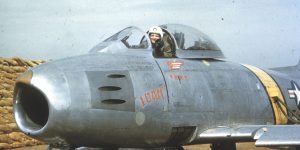26 July 19United States Air Force test-pilot Iven Carl Kincheloe, Jr. is killed in an unsuccessful ejection attempt after the engine of his Lockheed F-104A-15-LO Starfighter, 56-0772, fails during takeoff at Edwards Air Force Base, California, United States. While flying a Bell X-2, Kincheloe became the first man to exceed 100,000 ft (30,500 m) of altitude, and he is often credited as the first man to enter outer space.

Captain Iven Carl Kincheloe, Jr., took off from Edwards Air Force Base in Lockheed F-104A-15-LO Starfighter 56-0772, acting as a chase plane for another F-104A which was flown by a Lockheed test pilot, Louis W. Schalk, Jr.
As the two supersonic interceptors began their climb out from the runway, a small control cable deep inside Kincheloe’s fighter failed, allowing the inlet guide vane of the F-104’s General Electric J79-GE-3 turbojet engine to close. With the suddenly decreased airflow, the engine lost power and the airplane started to descend rapidly.
Captain Kincheloe radioed, “Edwards, Mayday, Seven-Seventy-Two, bailing out.”
The early F-104 Starfighters had a Stanley Aviation Corporation Type B ejection seat that was catapulted or dropped by gravity from the bottom of the cockpit. 56-0772 was equipped with an improved Stanley Type C ejection seat. With the Starfighter well below 2,000 feet (610 meters), Kincheloe apparently thought that he needed to roll the airplane inverted before ejecting. This was actually not necessary and delayed his escape.

By the time he had separated from the seat and could open his parachute, he was below 500 feet (152 meters). The parachute did open but too late. Iven Kincheloe was killed on impact. His airplane crashed into the desert floor just over 9 miles (14.5 kilometers) from the west end of Runway 22 and was totally destroyed. Today, a large crater scattered with fragments of Kincheloe’s F-104 is still clearly visible.
Iven Kincheloe was just 30 years old.
Iven Carl Kincheloe, Jr., was a legendary test pilot. He was born 2 July 1928 in Wayne County, Michigan, the son of Iven Carl Kincheloe, a farmer, and Francis Emma Wilde. He started flying lessons when he was 14 years old, and by the time he was legally allowed to solo—on his 16th birthday—he had already accumulated over 200 flight hours. He entered the Air Force Reserve Officer Training Program (ROTC) at Purdue University, West Lafayette, Indiana, where he was an engineering student. While there, he met Air Force test pilot Chuck Yeager and decided that test flying was the career area that he wanted to pursue.
 On graduation, Kincheloe was sent to Arizona to begin his Air Force pilot training. After graduating, Second Lieutenant Kincheloe was sent to Edwards Air Force Base in southern California to work on the new North American Aviation F-86E Sabre. At Purdue, Kincheloe was a member of the Sigma Phi Epsilon (ΣΦΕ) fraternity, played football, and managed the track team. He was a member of the military honor society, the Scabbard and Blade, and the Gimlet Club, a booster organization supporting varsity sports at the university. Iven Kincheloe graduated in 1949 with a Bachelor of Science degree in Aeronautical Engineering. He was commissioned as a second lieutenant, United States Air Force Reserve, 17 June 1949.
On graduation, Kincheloe was sent to Arizona to begin his Air Force pilot training. After graduating, Second Lieutenant Kincheloe was sent to Edwards Air Force Base in southern California to work on the new North American Aviation F-86E Sabre. At Purdue, Kincheloe was a member of the Sigma Phi Epsilon (ΣΦΕ) fraternity, played football, and managed the track team. He was a member of the military honor society, the Scabbard and Blade, and the Gimlet Club, a booster organization supporting varsity sports at the university. Iven Kincheloe graduated in 1949 with a Bachelor of Science degree in Aeronautical Engineering. He was commissioned as a second lieutenant, United States Air Force Reserve, 17 June 1949.
Lieutenant Kincheloe deployed to Korea as a fighter pilot with the 4th Fighter-Interceptor Wing in August 1951, flying the F-86E Sabre as an escort for bomber formations. He was transferred to the 25th Fighter-Interceptor Squadron, 51st Fighter-Interceptor Group, and immediately began to shoot down enemy Mikoyan-Gurevich MiG-15 fighters. He was soon an “ace” with five confirmed kills.
Kinross Air Force Base, Michigan renamed Kincheloe Air Force Base in September 1959.
Sources: https://en.wikipedia.org/wiki/Portal:Aviation/Anniversaries/July_26, This Day in Aviation History by Bryan R. Swopes © 2018
